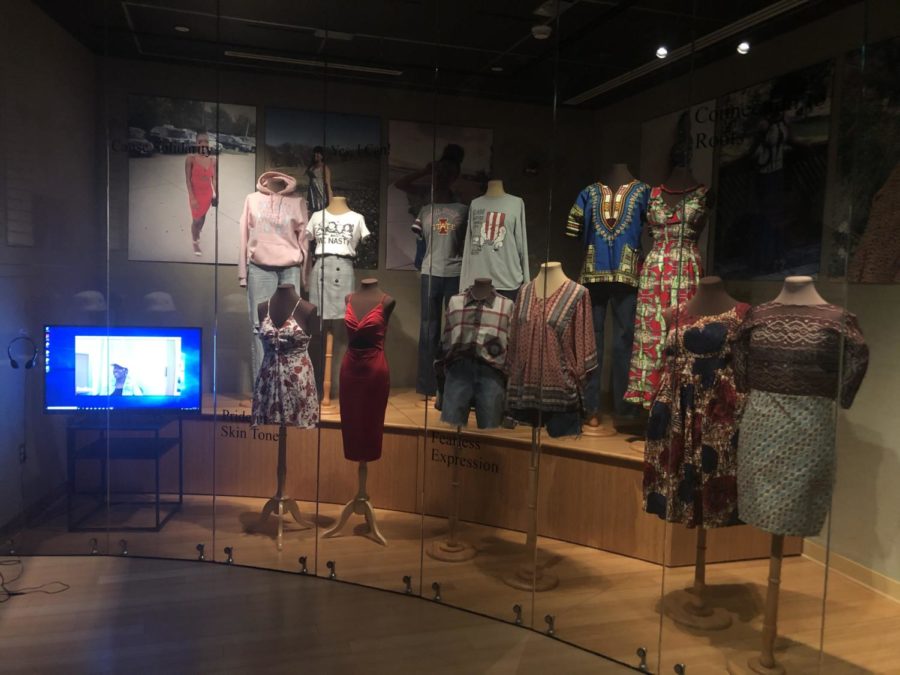Clothing exhibit features voices of 15 black women
February 3, 2020
Editor’s Note: A quote from a source included in the original publication of this article stated that the Krieger Board Room has paintings of only white men, which did not take into account the painting of Labh Hira, who is a past dean of the College of Business who does not identify as white. The Iowa State Daily regrets this error.
From hoop earrings and Doc Martens to dashikis and head wraps, Iowa State’s Textiles and Clothing Museum is displaying an exhibition on black women’s styles.
The exhibition “Collegiate Fashion and Activism: Black Women’s Styles on the College Campus” will be on display from Feb. 3 to April 17 in the Mary Alice Gallery in 1015 Morrill Hall.
“As humans, we communicate our many identities, such as race, gender and social class, through what we choose to wear,” according to the exhibition handout. “While the decisions we make to dress ourselves may not be conscious, they are always important, informative and reflect who we are.”
In “Collegiate Fashion and Activism: Black Women’s Styles on the College Campus,” the curators analyze the ways black women college students attending predominately white institutions in Iowa express their black identity, activism and expressions of empowerment through fashion. They focused on black women’s everyday clothing and its connection to black student empowerment on Iowa college campuses.
Fifteen black women college students who are currently attending predominately white institutions in Iowa shared stories through an in-depth interview about their fashion and style, which is on display for attendees to listen to as part of the exhibit.
The 15 black women college students who were interviewed for the exhibition are pictured in the exhibit and in an online catalog of the exhibit. Some of the women chose to blur their face or use a pseudonym for anonymity. The names of the women are Lucille, Princess, Nina, Donielle, Erica (pseudonym), Oni, Vashalice, Kara (pseudonym), Brea, Truth, Destiny, Viveca, Marie, Aja (pseudonym) and Bianca (pseudonym).
These same women collectively loaned 40 items that they discussed during their interviews, which are on display as the exhibit.
In addition to lending garments for the exhibition, the women also provided images, which were displayed throughout the exhibition in large-scale prints.
“These 48-by-36-inch images were hung throughout the gallery in response to the ways that large paintings of white men fill the halls of many university buildings,” according to the exhibition handout. “For example, the Krieger Board Room at Iowa State University has large paintings of [mostly] white men.”
Through 11 themes, the curators explored the ways black women represent themselves every day in predominately white spaces.
The 11 themes include Messages of Strength, 90s Throwback, Matriarch, Self-Created Expression, Pride in Skin Tone, Cause Solidarity, Connection to Roots, Fearless Expression, Yes I Can, Powerful Words and Black Girl Accessories.
“Matriarch” focuses on the strong black woman leader of the black family — in this case, the grandmother. Vashalice inherited her grandmother’s blue muumuu after her grandmother passed away in 2016. Vashalice wears this garment to remember her grandmother, who taught her how to be a strong black woman.
In “Messages of Strength,” the curators shopped at black-owned businesses and advocated for black people in positions of power. In this section, there are two t-shirts on display that demonstrate how “black women can overtly show messages of strength,” according to the exhibition’s online catalog.
The first shirt is titled “Phenomenal Women” and features images of Michelle Obama and other black women who represent the significance and history of black women’s impact on society.
The “Black Dollars Matter” t-shirt reflects the importance of supporting black-owned businesses in an effort to empower the black community.
“The phrase ‘Black Dollars Matter’ mirrors the phrase Black Lives Matter and the many initiatives of the movement, including resistance against white supremacy, uplifting black people and caring for black success,” according to the exhibition catalog.
The exhibition was curated by Dyese Matthews, masters student in the apparel, merchandising and design program, and Kelly Reddy-Best, assistant professor in the apparel, merchandising and design program.
Though the exhibit was completed, according to the exhibition’s online catalog, there were some issues along the way.
“Museums are fraught with white supremacy,” according to the exhibition’s online catalog. “In this exhibition, there were many instances of us needing to combat the continued and prolonged history of white supremacy.”
The first instance was with the mannequins.
“The available mannequins in the museum were all made of white fabric,” according to the exhibition’s online catalog. “Therefore, while we would have liked to use these mannequins as is for ease and time, we decided to cover all of the mannequins in different fabrics to represent the variety of skin colors of black women.”
The second instance dealt with the museum’s collection. Due to the few documented examples available of black women’s fashions in the museum’s collection, 100 percent of the garments are on loan.
The third instance was with the Institutional Review Board (IRB). Though the board approved all of the data collection methods prior to the interviews, there was a hiccup in the standard process. The curators requested that the participants be able to share photographs of themselves that “reflected pride in their black identity,” and one IRB reviewer made a statement about it.
“In this experience, the IRB reviewer asked that we include a clause that the ‘women not include any images with illegal imagery,’” according to the exhibition’s online catalog. “We questioned why this clause was needed, indicating that this would assume illegal behavior of black people, and the IRB reviewer reverted their request and approved our methods without the proposed clause.”







